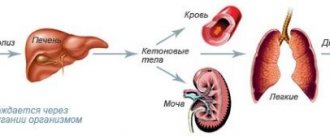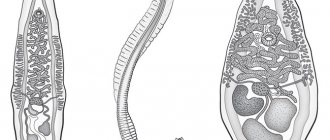Characteristics of chronic vaginitis
Chronic vaginitis (colpitis, vaginosis) is an inflammation of the vaginal mucosa. It is considered the most common pathology among the fair sex of reproductive age. Sometimes it can cover not only the mucous membrane of the vagina, spreading to the external genitalia.
This is what the inflammatory process of the vaginal mucosa looks like
Vaginitis can be specific, caused by pathogenic microorganisms, and nonspecific, when the cause of its occurrence is the growth of opportunistic microflora, which is normally present in the vagina.
This is what an inflamed vagina looks like
Chronic vaginitis is nothing more than a consequence of untreated acute inflammation. The disease enters a protracted phase of development. Almost 70% of women around the world who are sexually active are faced with this disease.
This is due to the following factors:
- decreased immunity in general;
- weakening of ovarian function;
- pathology of the genitourinary system;
- vaginal injuries;
- failure to comply with personal hygiene rules;
- degradation of vaginal tissue due to aging;
- infectious disease;
- environmental problems.
The body of any healthy woman is designed in such a way that when various pathogenic microorganisms enter the vagina, it self-cleanses. The microbes simply die. However, fewer and fewer people can boast of the strength of their health.
What is the danger of the disease
Alas, not all women, suspecting something is wrong, promptly seek qualified medical help from a doctor. More often they resort to self-medication, which leads to the disease becoming chronic. In this case, inflammation spreads to other organs:
- uterus;
- ovaries;
- the fallopian tubes;
- cervix;
- external genitalia.
The danger of chronic colpitis is that this disease has almost no obvious symptoms. The picture of the disease is often “blurred”. There is no discomfort or pain in the female genital area, and inflammation is sluggish and not pronounced.
Vaginitis: a doctor’s opinion about the disease - video
Bacterial vaginosis and vaginitis
Firstly, before talking about bacterial vaginitis, you need to immediately identify its difference from bacterial vaginosis. Bacterial vaginosis refers to a disorder of the vaginal microflora. There is a persistent decrease in the number of lactic acid bacteria in the vaginal cavity, which negatively affects its ability to fight infections and microorganisms penetrating the vagina.
With bacterial vaginitis, in addition to the listed problem, additional symptoms are also observed.
Thus, bacterial vaginosis and vaginitis are far from the same thing.
The main causes and factors of the disease in women
The main cause of vaginitis can be the following diseases and conditions:
- scarlet fever;
- measles;
- diabetes;
- hormonal disbalance;
- sexually transmitted diseases: gonorrhea;
- syphilis;
- chlamydia;
- mycoplasmosis;
Healthy and pathogenic vaginal environment
Symptoms
Only in very rare cases, chronic vaginitis can manifest itself as pain and dry vagina during sex.
The only obvious sign of chronic inflammation of the vaginal mucosa is unusual, copious discharge, sometimes with a disgusting odor (depending on the causative agent of the infection).
Burning and itching, redness and swelling do not always bother patients. In the absence of exacerbation, chronic vaginitis does not manifest itself as pain in the lower abdomen or bleeding.
Symptoms of chronic vaginitis during exacerbation
However, chronic colpitis has a tendency to periodic and regular relapses, which are associated with certain conditions of the woman’s body. It can be:
- menstruation;
- pregnancy;
- hypothermia;
- alcohol abuse;
- overwork;
- seasonal epidemics.
In this case, the following symptoms may rarely occur:
- redness and swelling of the external genitalia;
- burning and itching of the genitals;
- abundant vaginal discharge of various types (cheesy, purulent, milky, mucus-like) with an unpleasant, pungent odor;
- increased body temperature;
- frequent painful urination;
- aching pain in the lower abdomen;
- decreased libido;
- pain and discomfort during sexual intercourse.
Pain and discomfort in the lower abdomen may be symptoms of exacerbation of vaginitis
These are just signs common to all types of colpitis.
Specific signs
There are also specific features of the disease, which depend on the pathogens and the type of inflammatory process of the mucous membrane. Vaginitis caused by mixed pathogenic flora sometimes occurs.
Signs depending on the form of pathology - table
| Types of vaginitis | Discharge |
| Gonorrheal | With a pungent rotten odor, creamy, white or yellowish in color |
| Trichomoniasis (trichomoniasis) | Foamy, very abundant, greenish-yellow (sometimes brown) color, accompanied by heaviness in the pubic area |
| Bacterial (gardnerellosis, proteus, staphylococcal, streptococcal and others) | Abundant, transparent, jelly-like, with a fetid odor of spoiled fish |
| Candidiasis (fungal) | Curdled, thick, flakes, with a sour odor, accompanied by itching and swelling of the external genitalia |
| Atrophic (senile) | Watery, sometimes with pinpoint hemorrhages, accompanied by vaginal dryness |
Preventive actions
Women often wonder whether it is possible to prevent the development of such a disease. It's actually not difficult. It is enough to follow simple rules of prevention:
- Avoid sexual contact with unverified partners. Sexually transmitted diseases often cause vaginitis. If contact cannot be avoided, be sure to use a condom. But this cannot give a 100% guarantee.
- Inflammatory processes actively develop when hygiene rules are violated. Wash your face in the morning and evening using specialized products. During menstruation, this should be done more often.
- If possible, avoid using panty liners. They become a breeding ground for the proliferation of pathogenic microflora. If their use cannot be avoided, change them every two hours. Choose fragrance-free products.
- Synthetic underwear often looks more attractive and impressive. But wearing it has a beneficial effect on the development of pathogenic microflora. Give preference to linen made from natural materials.
- Prevention of vaginitis includes a healthy lifestyle. Eat right, exercise, spend more time outdoors. Then all gynecological problems will bypass you.
- Don't gain excess weight. Obesity leads to malfunctions of the hormonal system, which is fraught with various diseases, including vaginitis.
- She undergoes gynecological examinations in a timely manner. Timely treatment of all identified diseases is necessary.
- Douching is popular among people treating diseases that can be sexually transmitted. You should not get carried away with such a procedure. It can only be used as prescribed by a specialist. Otherwise, this will provoke a disruption of the natural balance of the vaginal microflora, and diseases may appear.
Symptoms and treatment of vaginitis are largely determined by the type of problem. Coping with such a gynecological disease must be under the supervision of a specialist with the mandatory use of medications. Strict adherence to all instructions will allow you to quickly cope with the problem and prevent complications from occurring.
Diagnostics
Only timely correct diagnosis and subsequent treatment can prevent complications, since there is a high risk of developing an ascending infection.
Preparing for the examination
Before contacting a doctor, you need to take a number of steps to prepare for the examination:
- A couple of days before visiting the gynecologist, you need to refuse:
- sexual intercourse;
- douching;
- vaginal suppositories and tablets.
- Perform a regular toilet of the genitals the evening before going to the doctor. However, you should not wash in the morning.
- Refrain from urinating 2-3 hours before your appointment.
Diagnosis stages
To diagnose vaginitis, the following research methods are used:
- Anamnesis collection.
- Gynecological examination or colposcopy.
- General tests: blood and urine.
- Blood chemistry.
- Microflora smear
- Bacteriological research.
- In case of viral damage to organs or in the case of normal indicators of all other tests, PCR is performed.
- If necessary and if another pathology is suspected, an ultrasound of the female organs is performed.
Vaginal smear examination is an important diagnostic step.
What is colposcopy
Colposcopy is performed in cases where it is not possible to conduct a gynecological examination using speculum or a detailed check of the vagina and cervix for the presence of complications:
- wall perforation;
- fistulas;
- abscess;
- ulcers
Urine and blood tests
Laboratory tests of urine and blood are necessary to determine the degree of inflammation and the general condition of the body.
General urine analysis - comparison table
| Index | Normal value | Changes in colpitis |
| Specific gravity | 1012—1024 | 1014– 1028 |
| pH reaction | slightly acidic | alkaline or neutral |
| Protein | No | 0.03-1 g/l |
| Epithelium | 1-3 in field of view | 25-30 in the field of view |
| Leukocytes | 1-2 in sight | 10-15 in the field of view |
| Red blood cells | No | 2-3 in field of view |
Blood test in comparison - table
| Index | Normal value | Changes in colpitis |
| Red blood cells | 3.2—4.3*1012/l | 3.0—3.5*1012/l |
| ESR (erythrocyte sedimentation rate) | 1—15 mm/h | 15—60 mm/h |
| Reticulocytes | 0,2—1,2% | 0,3—1% |
| Hemoglobin | 120—140 g/l | 120-130 g/l |
| Leukocytes | 4—9*109/l | 9—20*109/l |
| Platelets | 180—400*109/l | 170—380*109/l |
Flora smear
The study helps to identify the presence and type of pathogen.
Standards and deviations - table
| Index | Normal value | Changes in colpitis |
| Leukocytes | 10 in sight | 30 or more in sight |
| Flat epithelium | 5-10 in field of view | 25-40 or more in the field of view |
| Slime | moderate amount | a large number of |
| Microflora | Doderlein bacilli (lactobacillus) in large quantities | reduction of lactobacilli or their complete absence |
| Yeast | up to 104 CFU/ml (Colony Forming Unit) | over 104 CFU/ml indicates candidiasis colpitis |
| Key cells | missing or small amount | a large amount indicates gardnerelliosis (colpitis, the causative agents of which are gardnerelia) |
| Trichomonas | absent | a large amount indicates trichomoniasis |
| Gonococci | none | a large amount indicates gonorrhea |
| Streptococci | missing or small amount | a large number of |
| Staphylococcus | missing or small amount | a large number of |
| Enterococci | missing or small amount | a large number of |
| Escherichia coli | missing or small amount | a large number of |
| Leptothrix | absent | a large number of |
| Mobiluncus | absent | a large number of |
PCR research
PCR (polymerase chain reaction) is a method that determines the presence of an infectious agent in vaginitis. The accuracy of a correctly performed study reaches 100%. Detects single cells of bacteria or viruses even when other tests do not allow this. This diagnosis is especially effective in cases of latent pathology.
Treatment of colpitis
Treatment of colpitis in women involves eliminating the pathogens that caused the disease, restoring normal vaginal flora and stimulating the immune system. Self-medication of vaginitis is not allowed. Therapeutic measures are prescribed to all patients, regardless of their age and form of the disease, or the presence of concomitant pathology.
The general principles of treatment of colpitis are:
- etiotropic therapy;
- treatment of the patient's sexual partners;
- restoration of normal vaginal microflora;
- treatment of concomitant diseases;
- diet;
- the use of physiotherapy;
- traditional methods.
Treatment should be general and local. The main task is to fight the infectious agent. For this purpose, the following groups of drugs are used:
- Antibacterial (azithromycin, doxycycline, tetracycline, cefapexin);
- Antiprotozoal (metronidazole) - for the treatment of Trichomonas colpitis;
- Antifungals (fluconazole, ketoconazole, nystatin) - for the treatment of candidal colpitis;
- Antiviral agents (acyclovir, interferon).
Candles
Vaginal tablets and suppositories help to locally disinfect the mucous membranes of the vagina and help normalize the microflora and restore the acidic environment. They significantly alleviate colpitis - treatment in women involves the administration of the following drugs:
- Iodoxide;
- Betadine;
- Nystatin;
- Terzhinan;
- McMiror;
- Neotrizol;
- Lomexin;
- Fluomizin and similar.
Preparations for restoration of flora
In the final stage of treatment for colpitis, medications are prescribed to help restore the natural flora of the vagina and increase its protective properties.
For this purpose, a variety of drugs are used, in particular:
- Acylak;
- Vagilak;
- Bificol;
- Bifidumabacterin;
- Lactobacterin.
Physiotherapy
As a rule, if you seek medical help in a timely manner and adequately complete all necessary prescriptions, the course of treatment for vaginitis is 5-7 days. During this period, experts strongly recommend abstaining from sexual contact, and, if necessary, the patient’s sexual partner should be treated at the same time.
To monitor the cure of colpitis, smears are taken on the 4-5th day of menstruation in women of the reproductive period, in girls and menopausal women - after completing a course of treatment. To prevent relapse of the disease, the course of treatment should be repeated after 4-5 months.
As a rule, if you seek medical help in a timely manner and adequately complete all necessary prescriptions, the course of treatment for vaginitis is 5-7 days. During this period, experts strongly recommend abstaining from sexual contact, and, if necessary, the patient’s sexual partner should be treated at the same time.
How to treat chronic colpitis
The method of treatment depends on the concomitant disease that caused colpitis. That is, therapy is entirely aimed at eliminating provoking factors.
Drug therapy: an integrated approach
Any successful treatment requires an integrated approach.
- The use of drugs that affect pathogens is required:
- for the treatment of trichomonas colpitis use: Metronidazole;
- Tinidazole;
- Hexicon;
- For the treatment of candidal vaginitis the following is used:
- Ketoconazole;
- Miconazole;
- Pimafucort;
- Clotrimazole;
- Nystatin;
- Fluconazole;
- for the treatment of bacterial specific colpitis:
- Metronidazole;
- macrolides: Erythromycin;
- cephalosporins: Ceftriaxone;
- Clindamycin.
- Hormonal drugs are used to treat atrophic vaginitis:
- Klimonorm;
- Ovestin.
- For the treatment of chronic nonspecific colpitis, a doctor may prescribe one of the following medications (vaginal suppositories) as local therapy:
- Polygynax;
- Terzhinan;
- Vocadine;
- Mikozhinax.
- To eliminate discomfort and relieve symptoms, antiseptics and disinfectants are used:
- soda solution;
- potassium permanganate;
- boric acid;
- Miramistin;
- Chlorhexidine.
- At the same time, correction of concomitant ailments that can provoke the development of vaginitis, such as diabetes mellitus, obesity, hormonal dysfunction, and hypothyroidism, is carried out.
Restoring the immune system and vaginal microflora is one of the main stages of treatment, regardless of the type of vaginitis. Therefore, at this stage of therapy the following drugs are used intravaginally:
- Bifidumbacterin;
- Bificol;
- Lactobacterin;
- Acylact;
- Baktisubtil.
The therapeutic treatment plan is drawn up by the doctor. And only he prescribes or cancels medications. Self-medication is prohibited.
Medicines for vaginitis - photo gallery
Terzhinan has antifungal, bactericidal and antibacterial effects
Bifidumbacterin - suppositories for vaginal administration, intended to normalize microflora
Klimonorm is used in the treatment of atrophic colpitis
Clindamycin is a semisynthetic antibiotic of the lincosamide group. Metronidazole is an antiprotozoal and antimicrobial drug.
Miramistin has a wide spectrum of antimicrobial action
Fluconazole is a common synthetic antifungal drug.
Is it possible to cure pathology using traditional methods?
Even the use of traditional methods of treatment should be done under the supervision and consent of a doctor. All of them are just an addition to the main therapy. A positive effect can only be achieved through the interaction of modern antibacterial drugs and folk remedies.
To disinfect the mucous layer of the vagina and restore its microflora, decoctions and infusions of plants are often used.
- Infusion of chamomile flowers, calendula and sage leaves: Take crushed plant materials in equal proportions (or a ready-made pharmaceutical herbal mixture).
- Mixture in the amount of 2 tbsp. spoon, pour one glass of boiling water, leave for a couple of 30 minutes.
- Cool to room temperature, filter, squeeze.
- The resulting broth is added to a volume of 250 ml. Used for washing and douching.
- 2 tbsp. spoons of dry plant material are poured into 500 ml of boiling water.
- The infusion is prepared in a thermos. For this, 2 tbsp. spoons of dried leaves are poured into 1 liter of fresh boiling water.
- To prepare the solution, 100 g of freshly prepared raw materials are poured with a liter of boiled warm water.
- A small ball of propolis is placed in a non-metallic container.
- Herbs are mixed in equal proportions.
- Washed walnut tree leaves in the amount of 100 g are poured with one liter of boiling water.
- The herbal mixture (in equal proportions of all components) in a volume of 30 g is brewed with 300 ml of boiled water.
- About 30 g of plant material is poured into 0.5 liters of boiling water.
- The zest of 1 lemon is mixed with rose hips (25–30 g) and yarrow (15 g).
Healing herbs used in the treatment of colpitis - photo gallery
Chamomile flowers help with many inflammatory diseases
Calendula relieves inflammation
Horsetail will help relieve external symptoms of vaginitis
Celandine is an excellent antiseptic
Young pine branches help with many inflammations
Sweet clover is an excellent addition to herbal preparations for inflammatory processes.
Yasnotka will have a beneficial effect on the vaginal mucosa
The cuff will help in the healing of wounds and cracks, in the restoration of the mucous membrane
Rosehip is a storehouse of vitamins
Yarrow disinfects and heals damage
The high content of micro- and macroelements in walnut leaves has a positive effect on the microflora of the mucous membrane
Mint will remove discomfort
Valerian will relieve swelling, soothe itching and burning
Sage will soothe itching and relieve inflammation during colpitis.
Indications and contraindications
The indicator of recovery for the patient is diagnosis. Let's undergo an examination and make sure that the colpitis has receded.
What is indicated during treatment:
- Both partners undergo a therapeutic course. Men do not get sick themselves, but they are carriers of diseases. Both need treatment.
- We use antiseptics during hygiene procedures.
- We include more fermented milk products in our diet.
- We wash girls with antiseptics after each act of urination and defecation. We take care of personal hygiene. We wash and iron the linen thoroughly.
What to avoid:
- We exclude intimate relationships. Even condoms are an irritant.
- We eliminate from the diet all sources of influence on the mucous membrane: salty and spicy foods.
- We exclude alcohol-containing drinks.
After completing the course, it is necessary to use drugs that allow you to completely restore the vaginal microflora. For these purposes, additional medications are prescribed: Atsilak, Bifikol, Lactobacterin.
Experts recommend undergoing sanatorium-resort treatment. Therapy in sanatoriums includes various baths and mud to improve the condition of female organs.
Prevention
Monitoring the state of microflora means periodically visiting a doctor. Colpitis can return in the form of relapses.
Preventive actions:
- once every six months we take a smear test for flora;
- We completely give up bad habits;
- We follow a diet – we eat salty and spicy foods less often;
- We take vitamins in autumn and winter – we strengthen the immune system;
- We carry out hygiene procedures twice a day;
- take a shower using intimate hygiene soap with a suitable pH;
- If possible, avoid panty liners.
Women are recommended to buy cotton underwear. If you have silk and tango panties in your wardrobe, use them, but only as needed. Natural fabrics allow the body to breathe, which is important in preventing illness.
Complications and consequences
Regardless of its type, chronic vaginitis requires medical intervention and mandatory qualified treatment. Otherwise, the infection can spread to the female genital organs or the urinary tract. Negative consequences may include:
- inflammatory processes in the uterus and ovaries;
- infertility;
- cervical erosion;
- ectopic pregnancy;
- premature birth;
- frigidity;
- development of oncology;
- infection of the unborn child and sexual partners.
Timely detection of the disease is halfway on the road to recovery. Treatment carried out rationally and in full allows you to count on success in defeating the disease.
Features and causes of the disease
Vaginitis in women is often diagnosed. This is an infectious disease that is accompanied by a strong inflammatory process. There are several varieties of this problem, which are non-infectious in nature. The disease can develop even in childhood. Sometimes hypothermia, stress or failure to comply with hygiene standards is enough for this. Adult women often get sick after unprotected sexual intercourse with an untested partner.
The resulting inflammation brings severe discomfort to the woman. It is accompanied by severe itching and discharge. May look like a sexually transmitted disease. If the problem is not recognized in time and treatment is not started, complications develop that negatively affect reproductive function. Of particular danger is the inflammatory process in which the uterus is involved.
About 70% of women know firsthand what vaginitis is. If the immune system is strong, then the risk of getting vaginitis is minimal. Therefore, the main preventive technique is considered to increase the protective functions of the body.
Causes
Inflammation of the vaginal mucous surfaces can be caused by many factors. The main reasons for the development of vaginitis are:
- Sexually transmitted infection. The impetus for the appearance of the disease is the penetration of pathogens of chlamydia, gonorrhea, mycoplasmosis and other problems into the body. Infectious vaginitis in such a situation is transmitted sexually. Therefore, having sex with a new partner without using a condom is dangerous.
- Violation of individual hygiene standards.
- Vaginitis often occurs in people suffering from endocrine disorders, such as diabetes or hypothyroidism.
- Injury to the genital organs. This can occur during rough sexual intercourse, during childbirth, when wearing hard synthetic underwear, or using contraceptives. Vaginitis is often preceded by improper installation of the intrauterine device.
- In childhood, the cause of the problem is an infectious disease, such as measles or scarlet fever.
- Hormonal changes in the body.
- The use of radiation or chemical therapy during the treatment of cancer.
- AIDS virus.
- Diseases of the gastrointestinal tract.
- Prolapse of the vaginal walls.
- Senile atrophy of the mucous membrane of the genital organs.
- An allergic reaction to the condom used or drugs that are inserted into the vagina.
- Long-term treatment with potent drugs.
All of the above factors contribute to the simple penetration of infection into the genital organs. A favorable atmosphere is created for its development and spread higher through the genitourinary system.
Experts give an affirmative answer to the question of whether vaginitis is sexually transmitted. Any pathogenic microflora can provoke the development of the disease: gonococci, streptococci, Proteus, E. coli, and so on. Therefore, after sex with an untested partner, it is recommended to wash the vagina using disinfectants, for example, Chlorhexidine. Afterwards, be sure to visit the gynecological office and take the appropriate tests.











